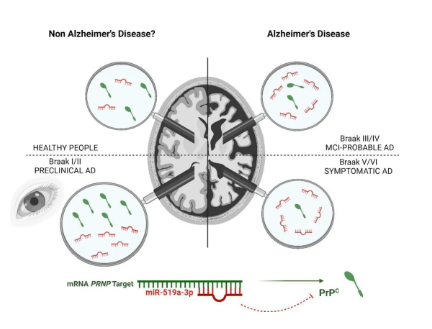Early screening website news: Recently, a research team from Spain published a study on a novel biomarker for Alzheimer's disease, mainly exploring the role of miR-519a-3p (a microRNA) in the pathogenesis of Alzheimer's disease (AD), especially its regulation of cellular prion protein (PrP ^ C), and evaluating its potential as a biomarker for asymptomatic stage AD. The study was published in BBA Molecular Basis of Disease as "miR-519a-3p, found to regulate cellular prion protein during Alzheimer's disease pathogenesis, as a biomarker of asymmetric stages.".

Let's first take a brief look at miR-519a-3p and PrP ^ C.
miR-519a-3p
MiRNAs play the role of gene expression regulators in cells, which can inhibit protein synthesis or promote the degradation of messenger RNA (mRNA) by complementary pairing with target mRNA, thereby regulating gene expression in cells.
MiR-519a-3p belongs to the miR-519 family and its expression levels can vary in various diseases. In terms of AD, MiR-519a-3p may affect pathological processes by regulating key genes associated with AD.
PrP^C
Cellular prion protein, PrP ^ C, is a membrane protein expressed in normal cells and is highly expressed in neurons and glial cells of the central nervous system (CNS). PrP ^ C is believed to be involved in various biological functions, including intercellular communication, neuroprotection, and the metabolic process of beta amyloid protein (A β) that may be associated with AD.
Although scientists have limited understanding of PrP ^ C and only know that it may be important in intercellular communication and protecting nerve cells, studies have shown that it may play a dual role in the pathogenesis of Alzheimer's disease, providing both neuroprotection and promoting neurotoxicity.
Given the stability and detectability of miRNA in body fluids, it has become a highly anticipated biomarker in some diseases such as cancer detection. However, MiRNA as a biomarker for AD has also begun to show great potential. Especially, MiR-519a-3p has been recognized as a potential biomarker for mild cognitive impairment (MCI) and AD due to its abnormal expression in AD patients.
The main objective of this study is to investigate the role of miR-519a-3p in the pathogenesis of AD, particularly how it regulates the expression of PrP ^ C, and to evaluate the potential of miR-519a-3p as a biomarker for the asymptomatic stage of AD.

The study involved analysis of 25 postmortem hippocampal samples and 106 prefrontal cortex samples from the non neurodegenerative disease (nND) control group AD patients, as well as other non AD tauopathies and synucleinopathies patients.
The research results show that, The expression level of miR-519a-3p is significantly upregulated in the brain samples of AD patients, especially in the asymptomatic stage, where its increase occurs before the onset of cognitive decline. In addition, in ROC curve analysis, MiR-519a-3p can better distinguish between AD patients and non AD patients, and compared to other neurodegenerative diseases, The upregulation of miR-519a-3p expression appears to be unique to AD, increasing its potential as a specific biomarker for AD.
Summary
The study revealed that miR-519a-3p plays a crucial role in regulating PrP ^ C associated with AD. MiR-519a-3p may affect the pathological development of AD by reducing PrP ^ C protein levels.
This study enhances the understanding of the molecular mechanisms in the early stages of Alzheimer's disease and provides possible directions for developing new early detection and treatment strategies. Further research is needed to explore the application of miR-519a-3p in disease prevention and treatment.